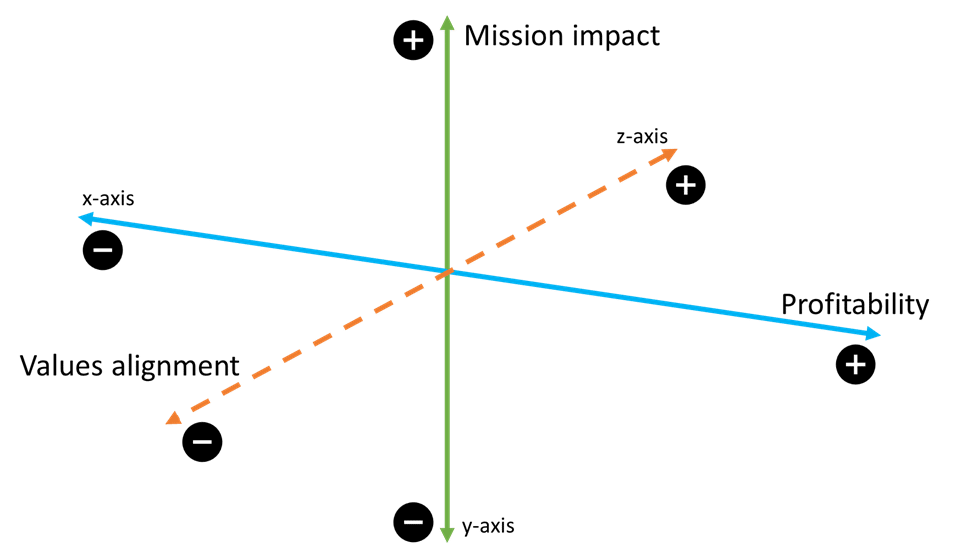The Expanded Matrix Map: Leveraging Your Triple Bottom Line for Fundraising
In today’s changing world, adding organizational values into the Matrix Map is crucial for nonprofits to demonstrate the impact of funding.

With the complexity and interconnectivity we have today, it’s more important than ever to align our programs with our values.
As nonprofits, we are always trying to do more with less. And while we are working hard, striving for greater impact, it can be tough to find the time, money, and other resources to assess whether we’re meeting our goals in ways that contribute to our mission and vision.
That’s where the Matrix Map comes in. The Matrix Map is a wonderful tool that helps us evaluate our programs based on a double bottom line: Mission impact and profitability.
But in today’s rapidly changing world, we need to expand the Matrix Map to include organizational values as a triple bottom line, using this Expanded Matrix Map to show grantors and donors alike the impact of their funding. Here’s why and how to do just that.
Why We Need to Add Values to the Matrix Map
Organizational values are the beliefs and principles that guide our actions and decisions; these values also guide our cultures and affect the efficacy of our pursuit of mission. They’re the foundation of our internal culture, but they also shape the way we interact with the external world. In today’s complex and interconnected world, it’s more important than ever to align our programs with our values.
Let’s take a look at a few reasons why this alignment is so important.
Values drive engagement.
When our programs align with our values, it’s easier to engage staff, volunteers, and donors. That is, people are more likely to get involved and stay involved when they feel a sense of purpose and connection.
However, there’s also a dangerous inverse to this principle. If employees, volunteers, donors, or clients feel a misalignment — perhaps between the organization’s stated values and what is actually being done — the likelihood of turnover, volunteer resignation, donor hesitancy, and lack of program engagement increases.
Values promote sustainability.
When we make decisions based on our values, we are more likely to make choices that align with our long-term goals. A focus on values-guided programs moves our missions forward and helps us avoid unnecessary expenses on misaligned programs. This safeguard helps us maintain financial sustainability while pursuing mission.
Values-aligned programs are also more likely to succeed — and thus be sustainable — over the long term. Those involved with a values-aligned program (employees, donors, volunteers, clients, and more) will come back again and again with enthusiasm when they feel the alignment of values uniting programs and the organization with themselves.
Values create impact.
When our programs align with our values, they’re more likely to create meaningful impact that advances our organizations towards our missions and visions. Values — such as equity, justice, and/or compassion — can help us design programs that have a clear direction and get to the true root cause of issues, enabling them to be more effective and transformative. Sticking to our values creates bonds of trust with our stakeholders, allowing for stronger relationships that enable deeper, longer-lasting, positive impacts.
Values inspire innovation.
Values play a critical role in fostering innovation within nonprofit organizations. Values like creativity, adaptability, and risk-taking (among others) can create an environment conducive to innovation. Organizational alignment around values fosters a healthy culture where each individual feels more in sync with and more trustful of one another. This environment then encourages staff to work together to come up with new and innovative approaches to social problems without fear of reprimand (formal or social) if failure occurs. By working together, we create programs that are more effective than those that are developed in isolation.
Adding Values to the Matrix Map
So how do we add values to the Matrix Map? It’s actually fairly straight-forward — we just need to add a third dimension to the grid created by the original Matrix Map. But let’s break this down into a step-by-step process.
Step 1: Start with the original Matrix Map.
Remember, the Matrix Map is a two-dimensional grid that plots programs based on their mission impact and profitability. The cost of each program is represented by the size of the program’s mark on the grid.
Let’s start by creating a Matrix Map for your organization using your existing data or estimates. To do this, I would recommend following the extant wonderful guidance in Bell, Masaoka, and Zimmerman’s book, Nonprofit Sustainability, as well as the corresponding Blue Avocado articles, How to Make the Matrix Map and The Strategic Imperatives.
Step 2: Identify your organizational values.
Ask yourself, staff, and other stakeholders the following question: what are the core values that guide your organization (i.e., joy, sustainability, equity, innovation, etc.)?
Identify the top 3-5 values that are most important to your organization.
Step 3: Assess programs for values alignment.
Develop a system for assessing your programs for alignment with your chosen organization values. This process is going to be unique to each organization.
One possible method is assessing each program for alignment with each of your values using a 1-5 scale (1 = not aligned, 5 = fully aligned). You could plot each score individually on separate value maps or create an average score.
Important Note: Remember that axes on a graph can cross one another at any value, not necessarily only at zero! If you score values alignment on a 1-5 scale, the other axes will likely cross this axis at 2.5. That means the values below 2.5 are more weakly aligned with mission but not necessarily “negatively aligned.” This is why the Expanded Matrix Map does not show zeroes or other numbers, but rather only plus and minus signs, indicating relative higher and lower (not negative) values.
Although the scoring rubric will be different for each organization according to needs and capacity, one way to proceed may be to inquire internally about value alignment via an online survey. Whether you use a fee-based service like Qualtrics or something free like Google Forms, you can ask employees to anonymously rank each value on the scale you are using. You can then plot the average score of each value on your map. With a little extra demographic data, you could find the average score according to position level as well to check for perception discrepancies within the organization.
For the data-inclined, there is also the possibility of mapping all values individually and simultaneously through multidimensional data plotting. However, this may be beyond the time and/or expertise of a nonprofit organization, especially those with limited (and often over-worked) data analysts.
Step 4: Plot programs on the three-dimensional grid.
Once you have your Matrix Map and your organizational values, it’s time to plot your programs on the three-dimensional grid. Plot each program according to its profitability (x-axis), mission impact (y-axis), and values alignment (z-axis). Make the size of the marker for each program correspond to its costs.
Step 5: Assess and compare programs.
Once you have your programs plotted on the grid, it’s easy to assess and compare them based on their alignment with your values, as well as their mission impact and profitability.
To help analyze this Expanded Matrix Map, consider using this Interpretive Guide.
Identifying these characteristics through data visualization should help inform strategic decisions about where to invest (or divest) your resources.
Leveraging the Expanded Matrix Map for Direct Funding
If you know how to use it, the Expanded Matrix Map (EMM) can be a powerful tool for grant writing and development work.
For example, you might consider using the EMM when applying for grants. It can help showcase your organization’s impact and alignment with the funder’s values. By demonstrating how your programs align with the funder’s priorities and values, you can increase your chances of securing those grant dollars. Don’t be afraid to find how values also align with your overhead costs. Though nonprofit “overhead” is the topic of current public scrutiny (that is, luckily, starting to shift), we know it is what keeps our organizations running daily. Showing how these costs align with your values can paint the picture of how critical they are to achieving your mission.
You might also use the EMM when communicating with donors. You can use the EMM to show the impact of their donations and demonstrate how their contributions align with your organization’s values. This can help build stronger relationships with donors and increase their engagement with your organization. Showing the success of programs that stick to your core values creates a trust with donors that can potentially yield higher future donations.
Other (Funding-Focused) Applications of the Expanded Matrix Map
But wait — there’s more! The EMM is good for many things beyond grant applications and extant donor communications. It can also help your organization in the following ways:
Identify success stories.
Look for programs that are highly aligned with your values, have a high mission impact, and are profitable. These are your success stories. Use them to showcase your organization’s impact and attract new donors and partners (among other things). Take lessons learned and apply them to programs that need a refresh to reach their highest potential.
Identify underperforming programs.
Look for programs that are not aligned with your values, have a low mission impact, or are not profitable. These are your underperforming programs. Use the EMM as your prompt to identify the root causes of their misalignment and develop strategies to change or invest in those programs that can improve. Be prepared to make decisions around programs that are identified as unsalvageable — it may be time to cut these programs or work on transferring them to another organization where they can thrive.
Focus your strategic planning.
Use the EMM to guide your organization’s strategic planning process. By aligning current and future programs, investments, or capital projects with your organizational values while assessing their impact and profitability, you can develop a more focused and effective strategic plan.
Bringing It Together
For almost a decade, the Matrix Map has been a valuable tool for assessing programs based on their mission impact, profitability, and cost. But in today’s world of rapid societal and environmental change, it’s prudent to expand the Matrix Map to include organizational values. By adding this third bottom line, we can assess programs based on their alignment with our values as well as their mission impact and profitability.
The Expanded Matrix Map will help us create more sustainable, impactful, and innovative programs and make a stronger case for investing in underperforming programs while guiding our decisions to cut unsalvageable programs. In this way, we can step confidently into the future, knowing that data has paved the way for our success.
Interpretive Guide for the Expanded Matrix Map
About the Author
Ryan Gott, PhD, is a nonprofit professional in the Pittsburgh, Pennsylvania, public horticulture and place-based cultural institution sector. He is an avid educator, having taught for nearly 13 years in settings from formal college classrooms to public science festivals. Gott is an enthusiastic advocate for sustainable landscaping and has a particular interest in Eastern North American native plants, managing a personal home collection of over 150 species as an ecologically functional habitat.
Most recently, Gott received the Longwood Fellowship, a 13-month immersive, residential, cohort-based program at Longwood Gardens that provides hands-on training and development opportunities for emerging leaders to gain self-insight and build capacity. Fellows receive mentorship, engage in extensive individual and group-based projects, participate in leadership development programs, and work at a 2-month international field placement at partner gardens.
Gott received his bachelor’s degree in biology from Purdue University and his doctoral degree in entomology from the University of Maryland.
Articles on Blue Avocado do not provide legal representation or legal advice and should not be used as a substitute for advice or legal counsel. Blue Avocado provides space for the nonprofit sector to express new ideas. Views represented in Blue Avocado do not necessarily express the opinion of the publication or its publisher.













I appreciate the thoughtfulness of bringing the values alignment into this conversation. I agree with all the points about why values are critical to nonprofit and community benefit success.
I would be great to see a visual example of the 3-demensional plotting. It does seem like it could be challenging to manage the 4 different variables at once (mission, financial, effort/investment, and values) without losing people.
I wonder, if based on the importance of values alignment, do we consider a pre-screen against values first before even assessing mission and financials.
Values are the fundamental building block to behavior and making the decisions and taking the actions that lead to a healthy community for all. Seems like something that is not being done in alignment with the values that we say matter, it should be non-negotiable. Either it is done in alignment with the values or we don’t do it. I call this the gracious intolerance of values misalignment.
Love that values are being brought into this critical strategy and planning space.
I appreciate the thoughtfulness of bringing the values alignment into this conversation. I agree with all the points about why values are critical to nonprofit and community benefit success.
I would be great to see a visual example of the 3-demensional plotting. It does seem like it could be challenging to manage the 4 different variables at once (mission, financial, effort/investment, and values) without losing people.
I wonder, if based on the importance of values alignment, do we consider a pre-screen against values first before even assessing mission and financials.
Values are the fundamental building block to behavior and making the decisions and taking the actions that lead to a healthy community for all. Seems like something that is not being done in alignment with the values that we say matter, it should be non-negotiable. Either it is done in alignment with the values or we don’t do it. I call this the gracious intolerance of values misalignment.
Love that values are being brought into this critical strategy and planning space.